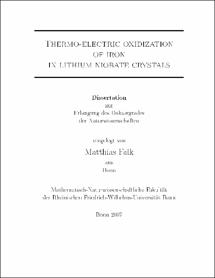Falk, Matthias: Thermo-electric oxidization of iron in lithium niobate crystals. - Bonn, 2008. - Dissertation, Rheinische Friedrich-Wilhelms-Universität Bonn.
Online-Ausgabe in bonndoc: https://nbn-resolving.org/urn:nbn:de:hbz:5N-13469
Online-Ausgabe in bonndoc: https://nbn-resolving.org/urn:nbn:de:hbz:5N-13469
@phdthesis{handle:20.500.11811/3594,
urn: https://nbn-resolving.org/urn:nbn:de:hbz:5N-13469,
author = {{Matthias Falk}},
title = {Thermo-electric oxidization of iron in lithium niobate crystals},
school = {Rheinische Friedrich-Wilhelms-Universität Bonn},
year = 2008,
note = {Lithium niobate crystals (LiNbO3) are a promising material for nonlinear-optical applications like frequency conversion to generate visible light, e.g., in laser displays, but their achievable output power is greatly limited by the "optical damage", i.e., light-induced refractive-index changes caused by excitation of electrons from iron impurities and the subsequent retrapping in unilluminated areas of the crystal. The resulting space-charge fields modify the refractive indices due to the electro-optic effect. By this "photorefractive effect" the phase-matching condition, i.e., the avoidance of destructive interference between light generated at different crystal positions due to the dispersion of the fundamental wave and the converted wave, is disturbed critically above a certain light intensity threshold.
The influence of annealing treatments conducted in the presence of an externally applied electric field ("thermo-electric oxidization") on the valence state of iron impurities and thereby on the optical damage is investigated. Itis observed that for highly iron-doped LiNbO3 crystals this treatment leads to a nearly complete oxidization from Fe2+ to Fe3+ indicated by the disappearance of the absorption caused by Fe2+. During the treatment an absorption front forms that moves through the crystal. The absorption in the visible as well as the electrical conductivity are decreased by up to five orders of magnitude due to this novel treatment. The ratio of the Fe2+ concentration to the total iron concentration - a measure for the strength of the oxidization - is in the order of 10-6 for oxidized crystals whereas it is about 10-1 for untreated samples. Birefringence changes are observed at the absorption front that are explained by the removal of hydrogen and lithium ions from the crystal that compensate for the charges of the also removed electrons from Fe2+. A microscopic shock-wave model is developed that explains the observed absorption front by a self-enhancing oxidization process due to the increase of the crystal resistance and the subsequently enhanced voltage drop over the oxidized volume.
Undoped congruently melting LiNbO3 crystals are also thermo-electrically oxidized. Measurements of light-induced birefringence changes are utilized to show that the optical damage in these crystals is suppressed by one order of magnitude. This effect is explained within the framework of the one-center model by the nearly complete oxidization. The maximum achievable frequency-doubled light output power is measured for thermo-electrically oxidized and periodically-poled congruently melting LiNbO3 crystals. An output power of up to 3 W light of the wavelength 515 nm is realized at 90 °C instead of about 30 mW output power for untreated crystals.},
url = {https://hdl.handle.net/20.500.11811/3594}
}
urn: https://nbn-resolving.org/urn:nbn:de:hbz:5N-13469,
author = {{Matthias Falk}},
title = {Thermo-electric oxidization of iron in lithium niobate crystals},
school = {Rheinische Friedrich-Wilhelms-Universität Bonn},
year = 2008,
note = {Lithium niobate crystals (LiNbO3) are a promising material for nonlinear-optical applications like frequency conversion to generate visible light, e.g., in laser displays, but their achievable output power is greatly limited by the "optical damage", i.e., light-induced refractive-index changes caused by excitation of electrons from iron impurities and the subsequent retrapping in unilluminated areas of the crystal. The resulting space-charge fields modify the refractive indices due to the electro-optic effect. By this "photorefractive effect" the phase-matching condition, i.e., the avoidance of destructive interference between light generated at different crystal positions due to the dispersion of the fundamental wave and the converted wave, is disturbed critically above a certain light intensity threshold.
The influence of annealing treatments conducted in the presence of an externally applied electric field ("thermo-electric oxidization") on the valence state of iron impurities and thereby on the optical damage is investigated. Itis observed that for highly iron-doped LiNbO3 crystals this treatment leads to a nearly complete oxidization from Fe2+ to Fe3+ indicated by the disappearance of the absorption caused by Fe2+. During the treatment an absorption front forms that moves through the crystal. The absorption in the visible as well as the electrical conductivity are decreased by up to five orders of magnitude due to this novel treatment. The ratio of the Fe2+ concentration to the total iron concentration - a measure for the strength of the oxidization - is in the order of 10-6 for oxidized crystals whereas it is about 10-1 for untreated samples. Birefringence changes are observed at the absorption front that are explained by the removal of hydrogen and lithium ions from the crystal that compensate for the charges of the also removed electrons from Fe2+. A microscopic shock-wave model is developed that explains the observed absorption front by a self-enhancing oxidization process due to the increase of the crystal resistance and the subsequently enhanced voltage drop over the oxidized volume.
Undoped congruently melting LiNbO3 crystals are also thermo-electrically oxidized. Measurements of light-induced birefringence changes are utilized to show that the optical damage in these crystals is suppressed by one order of magnitude. This effect is explained within the framework of the one-center model by the nearly complete oxidization. The maximum achievable frequency-doubled light output power is measured for thermo-electrically oxidized and periodically-poled congruently melting LiNbO3 crystals. An output power of up to 3 W light of the wavelength 515 nm is realized at 90 °C instead of about 30 mW output power for untreated crystals.},
url = {https://hdl.handle.net/20.500.11811/3594}
}






